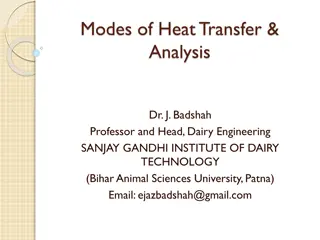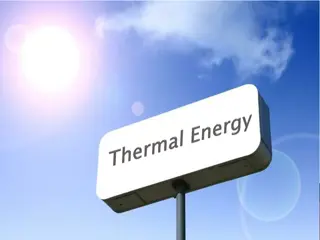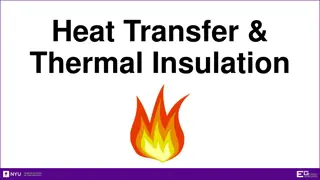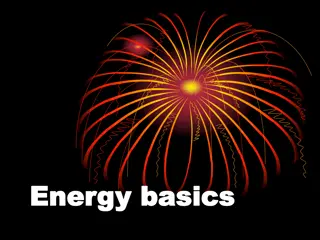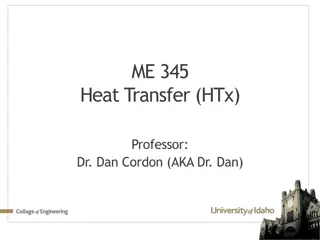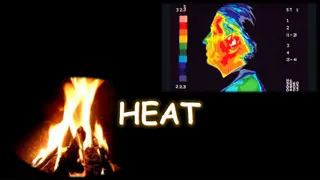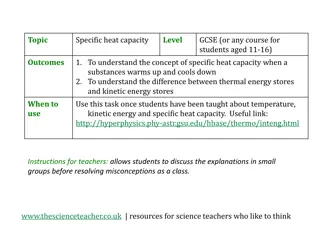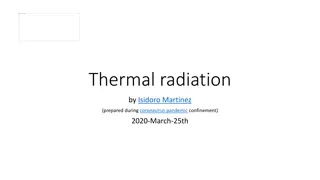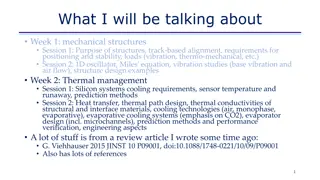Understanding Thermal Energy Transfer Methods
Explore the three primary ways thermal energy is transferred - conduction, convection, and radiation. Dive into the characteristics of good conductors, such as metals, and how they facilitate heat transfer. Learn about the role of insulators in controlling thermal energy flow and discover the best heat conductors like silver, copper, and aluminum.
Download Presentation

Please find below an Image/Link to download the presentation.
The content on the website is provided AS IS for your information and personal use only. It may not be sold, licensed, or shared on other websites without obtaining consent from the author. Download presentation by click this link. If you encounter any issues during the download, it is possible that the publisher has removed the file from their server.
E N D
Presentation Transcript
Section 2: Transferring Thermal Energy Chapter 6: Thermal Energy
WARM-UP: What does it mean to be a good conductor? What types of materials are the best conductors?
LEARNING GOALS Compare the transfer of heat energy through conduction, convection, and radiation. Compare and contrast conductors and insulators. Explain how insulators are used to control the transfer of thermal energy.
TRANSFERRING THERMAL ENERGY There are 3 ways that thermal energy is transferred from place to place: Conduction Convection Radiation
CONDUCTION Conduction: transfer of thermal energy by collisions between particles in matter Think of a metal spoon being heated by a flame.
CONDUCTION Kinetic energy of the particles close to the flame increases. Those particles collide with the particles close to them and thermal energy is transferred.
CONDUCTION Conduction occurs when thermal energy is transferred from place to place without the transfer of matter!
HEAT CONDUCTORS Heat moves fastest by conduction in solids.
HEAT CONDUCTORS Heat moves a little slower by conduction in liquids.
HEAT CONDUCTORS Heat moves the slowest by conduction in gases because the particles are so far apart.
HEAT CONDUCTORS The best conductors of heat are metals because their electrons flow freely through the metal. Silver, copper, and aluminum are among the best conductors of heat.
CONVECTION Convection: transfer of thermal energy in a fluid (liquid or gas) by the movement of warmer and cooler fluid from place to place.
CONVECTION More energetic particles collide with less energetic particles and transfer thermal energy. More energetic particles move faster from place to place.
CONVECTION THE LAVA LAMP Oil is cool and dense and sits on the bottom of the lamp. As it warms, the oil expands and becomes less dense than the surrounding fluid.
CONVECTION THE LAVA LAMP The oil then rises and loses heat to the surrounding fluid. It becomes dense again and sinks.
RADIATION Radiation: transfer of energy by electromagnetic waves Energy transferred by radiation is called radiant energy.
RADIATION When you stand near a fire to warm your hands, you are warming them using radiation.
INSULATORS Insulator: material that slows down heat transfer Gases are usually much better insulators than solids or liquids. Conduct heat poorly since particles are far apart.
INSULATORS Examples: fleece jacket and thermos
CHECK-IN: Would plastic foam (which contains pockets of air) be a good insulator or good conductor? Explain why.



